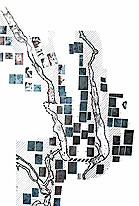April-May 2005 in Italy and Malta
Click on any thumbnail to see a larger image
Pages
April
17-22 Rome
Arrival in Rome,
Tourists in
Rome
April
22-24 Bay of Naples
Herculaneum,
Sorrento,
Vesuvius
April 24-27 Capri
April
27-29 Amalfi to Maratea
Amalfi Coast and
Paestum,
Maratea
April
29-May 3 Sicily
To Sicily,
Sicily (Taormina),
Mosaics at Villa Imperiale
di Casale,
Etna,
Valley of the Temples,
Siracusa
May
3-6 On
Malta
Blue Grotto and Temples,
Valetta
and Archaeological Museum,
Exhibits in Archaeological Museum
Hypogeum,
Gozo and Ggantija,
Tarxien
and Clapham Junction
May 6-7 Sicily, Scilla and Charybdis
May 7-8 Tropea (Capo Vaticano)
May
8-10 Puglia
Matera,
Grotto, Trulli of Alberobello
May 10-12 Abruzzi National Park
May 12 Tivoli, Villa Adriana
Grotto di Castellana
The next day, we took a circle drive eastward around Puglia (the heel of the Italian boot), visiting a fascinating cave called the Grotto di Castellana and the trulli houses in and around Alberobella. Both are Michelin 3-star attractions.
To go east from Matera involves crossing the gorge. Fortunately, at the north end of the town, it flattens into a valley, down and across which the road can run. On the far side is rolling farmland. We used small roads that could have been in farm country almost anywhere in Europe, with occasional long vistas, but mostly passing green fields and small villages or farmsteads. In my notes written that evening, I noted "The drive was through almost English rolling countryside. It just lacked hedgerows to be English."
 |
| The trees around the hole in the roof of the first big chamber |
Castellana seems to be built around the existence of the cave. The tower in the picture proclaims the Grotto to all and sundry, quite unnecessarily. We didn't go up the tower, though it probably gave a good view of the surrounding countryside. We came to see the cave, for which we had to buy tickets for the next English-speaking tour. We were lucky, in that an English-speaking tour was due to begin about 10 minues after we bought the tickets, and the next one would have been two hours later. Joining a tour is the only way to see the cave. Tours come in two varieties, short (one hour, about 1 km total) and long (two hours, 3 km to the end of the main chamber and back).
The tour starts with a warning about how cold it will be, followed by a walk down a long staircase to the first big chamber, which is 70 metres high by 50m wide and 110m long. There is a hole in the roof which must be a bit less than 10m in diameter, rather like the oculus in the Pantheon in Rome. The sun pours through this oculus, and the reflections off the rocks where the beam hits illuminates the rest of the chamber.
 |
| A map of part of the cave, from a display showing the various writings that were found in it. The big entrance chamber is outside the area of the map. |
The reflected light is not strong enough for photographs in most of this huge cavern, but added to flash, the lighting is enough. Photographs are allowed in this one chamber, but nowhere else in the cave, which is a shame, since there were so many beautiful places, not all of which were represented in the guidebooks. It is to protect the sales of the guidebooks that photos are prohibited, but that prohibition seems misguided if the bools don't show the pictures you would have liked to take. One in particular I would have like to take was of a small gap between two horizontal layers of stone. The gap. of maybe 10 cm, was filled with a forest of needle-thin white columns, tiny stalactites joined to their partner stalagmites. It was extraordinarily beautiful.
The cave consists of a main tunnel open to tourists, about 1.5 km long through a succession of large and small chambers and narrow passageways, with a number of long side tunnels, canyons, pits, pools and lakes, and changes of the mineral type, ending in the "White Cavern". The "White Cavern" is a moderately large chamber, perhaps 20 x 15 x 10m, with glittering white walls and stalagmite-stalactite columns. Tourists can see it only from a balcony at the end of the walkway, about 5m up from the floor.
It was inhabited, or at leased used, in prehistoric times, and many symbolic graffiti or religious symbols were found throughout the lengths of the different galleries. The little rectangles on the map are pictures of different symbol groups, showing where they were found (I don't think you can see them properly, even in the big map you see when you click the thumbnail). The map is a mosaic of six photographs I took of that display in order that I could examine the symbols at leisure, to compare them with prehistoric symbology found in other parts of the Eastern Mediterranean and Malta. As of this writing, I haven't done that yet.
I have to wonder how the prehistoric people breathed in the depths of the cave. As it is now, there are fans controlled by carbon dioxide sensors to bring fresh air into the depths, as there is no airway to the surface other than the hole in the roof of the huge entrance cavern. As for lighting, the tour guides turn the lights on and off as each tour group passes, so as to avoid excessive growth of algae that would not ordinarily be there. Even so, one does see green patches near some of the light fixtures.
And the light one sees when one emerges into the sunlight at the end of the two-hour tour is almost painfully bright!





